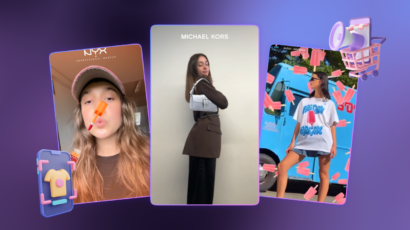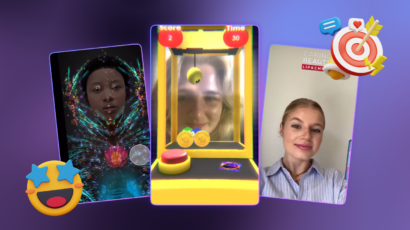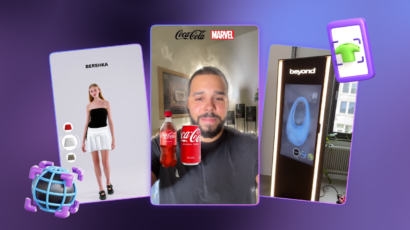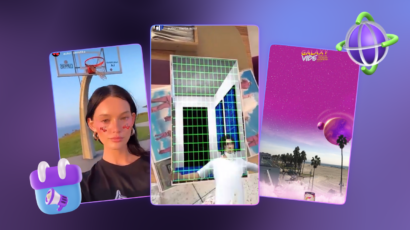Technology changes how we interact with the world around us. Thus far, numerous online experiences have been improved by Augmented Reality (AR), and the fashion industry is no exception. Fashion is all about creativity, and AR only serves to enhance this. According to NielsenIQ, 61% of consumers prefer retailers with AR experiences. Deloitte Digital surveyed more than 15,000 consumers in 2021 and discovered that 76% want to use AR in their frequent shopping. The statistics say a lot. AR is here to stay.
Augmented reality provides a more immersive and personal experience that allows users to try on clothes without ever leaving the comfort of their homes. Different AR tools can be applied to solve multiple pain points, such as finding more innovative advertising campaigns, differentiating themselves from competitors, as well as driving sales and reducing return rates. According to studies, addressing customer pain points with AR can have a significant positive impact.AR makes life easier for the fashion industry, offers unforgettable marketing campaigns, and improves user experience. Furthermore, the AR experience helps companies to educate their customers and offer more in-depth content.
Cut down on returns and boost sales with virtual try-ons
When the product doesn’t meet the customer’s expectations, buyers return the purchase. Shopping based on a stock photo is hard, people realize that it wasn’t what they imagined upon receiving it. According to NRF, in 2021, Americans returned $761 billion worth of goods, or nearly 17% of all retail sales. AR can solve the issue.
Studies show that people who used AR to try products were less likely to send purchases back. For example, Retail giant Macy’s “try before you buy” AR product visualization helped the company reduce return rates to less than two percent.
Gucci pioneered as the first luxury brand to collaborate with a social media platform to drive sales with an AR tool. Gucci created an AR app and enabled customers to virtually try on its new sneakers collection. The Italian brand went a step further and partnered with Snapchat to offer a virtual try-on experience through the messaging app.
Gucci’s virtual try-on experience was a triumph. It significantly boosted customer engagement and opened a new channel for driving sales. Originally, the brand initiated the campaign to generate awareness and boost engagement, but the newly incorporated AR feature created a strong incentive for the customers to purchase directly from the app, leading to skyrocketing product sales.
Try-on experiences can also be scaled up into the retail environment, with AR Mirrors. AR-enabled mirrors placed into fitting rooms, and in storefront windows, provide an enticing virtual fitting solution. Customers can try any piece of clothing without getting undressed. While standing in front of the mirror, buyers can swipe between different options and see clothes on their bodies. It’s interactive and enables better customer interaction while collecting data that can expand loyalty programs and track sales.
For example, Timberland turned its fitting room into one of the main window displays. Shoppers could see themselves on a large screen without going through the shop. They chose different products and tried them on virtually.
AR Portals: A new way to experience fashion week
In 2021, fashion’s leading digital platform, the Institute of Digital Fashion’s (IoDF) project merged the digital and physical universes and showed Richard Quinn’s latest collaboration with Royal Salute. The AR aimed to champion the work and bring it into the hands and homes of the masses.
The platform has created an AR universe, accessible via an Instagram filter, in which anyone can be a part of Quinn and Royal Salute’s hyperactive dreamscapes. To create a hypnotic effect, colors, time, and space have all been inverted. Too far into the future? IoDF suggested an absolutely new way to look at fashion weeks.
Drive social media traffic with viral face filters
One of the many marketing objectives that AR can help meet more effectively – is increasing customer trust in a specific brand. By utilizing AR in social media posts, virtual try-ons, and augmented reality clothing, customers are brought closer to the brand and brand awareness is raised through viral content in return. This is essential for fashion companies, as building trust and acceptance through brand recognition leads to customers trying the experience themselves and ultimately becoming customers. A notable example is Bershka, a clothing retailer, which created an AR filter featuring beautiful flowery patterns, which was widely used by Instagram users, and helped the company boost its impressions and reach, etc.
Increase organic reach with augmented reality mini-games
Mini-game filters are the most common and widely used types of AR filters. A fun filter that is highly engaging and, when combined with online competitions with sharing as the entry mechanism, is very effective at generating results.
A fashion brand iets frans that crafts modern clothes and made a mini-game ‘’Bubble Pop”. The AR filter is operated by using facial gestures and head movements. The campaign demonstrated its effectiveness in increasing user engagement.
Boost your sales with product visualisation
Fashion is a dynamic industry and staying up to date with the latest technology is essential to moving forward. It is all about making customers “happy and confident”. It’s crucial to create personalized experiences that show customers the way how to integrate the products in their daily lives. That’s what Nike did. Nike’s Instagram filter enabled people to visualize new sneakers on the street. Nike’s campaign is the best example of how the right product visualization strategies can boost sales and decrease returns.
Engage your audience with image tracking
Bershka loves AR. To promote its new collection the brand developed a new integration of Augmented Reality technology through Instagram filters. After scanning the QR code, people accessed the filter and focused their phone’s camera. The dolls on their T-shirts or accessories bring them to life.
Revolutionise the shopping experience with AR showrooms
Virtual showrooms are 360° environments created digitally that have the same look, feel, and function as physical showrooms. Buyers can “tour” the showroom by interacting with 3D product images and inspecting them from all angles. This type of AR or digital showroom is an innovative solution allowing customers to shop around in a digital environment. What they need is to move their smartphone around the room. After this, customers can tour the space and interact with items. It looks like they are visiting a standard physical store.
It is engaging and realistic because it creates an interactive space among customers and items. It is cost-effective because it reduces costs for physical showrooms. It analyzes visitors because using Google Analytics, the owner of the virtual showroom can get information about every visitor.
For example, Tommy Hilfiger was a starter, launching its first digital showroom in Amsterdam in 2015. The brand created an exclusive bespoke service and allowed its customers to take control.
The benefits of AR for sustainable fashion
Have you ever thought about how better AR in fashion is for the environment? Many brands waste a lot of materials to offer customized products. If they have an AR experience for those products, users will be able to try them only digitally, reducing waste. AR in the fashion industry reduces waste and emissions while also contributing to a more sustainable future. Digital fashion is entering the mainstream and slashing the waste generated by physical fashion both behind-the-scenes in the fashion industry.
A solution for the future
Fashion is an industry driven by visual and sensory excellence, and any immersive experience must reflect this. However, as consumer behavior evolves, augmented reality will become an increasingly appealing option for fashion brands to present, promote, and sell their products. Technological advancements are critical to adoption.
Implementing augmented reality technology into your fashion business is a solution that will pay off in the short and long run. However, incorporating it into your strategy can be difficult.
It is critical to select the right partner if you intend to use AR to enhance your product line. Crosscreators is here to creatively bring your vision to life and help you create unforgettable AR marketing campaigns.








